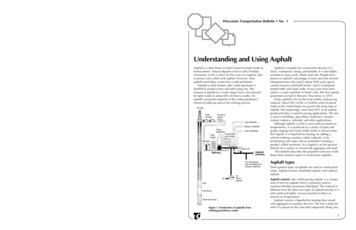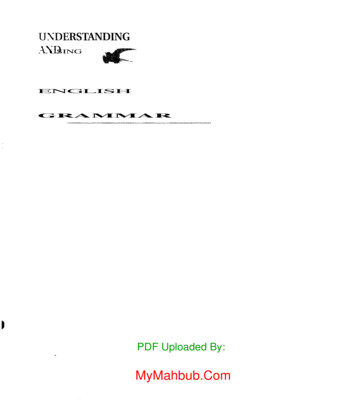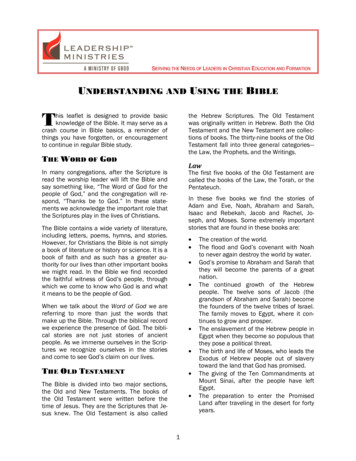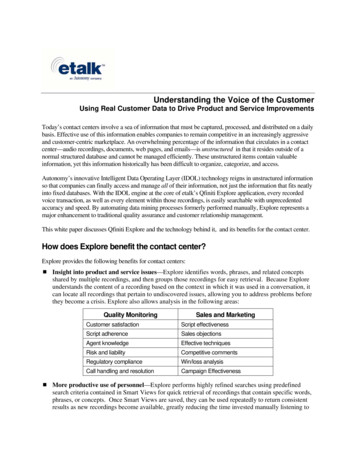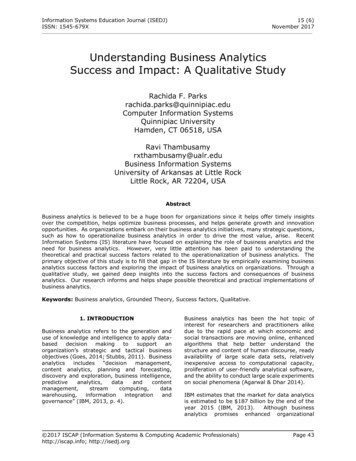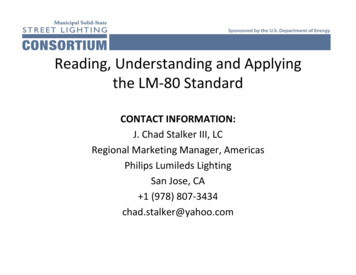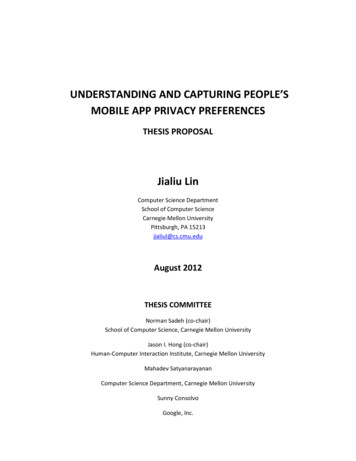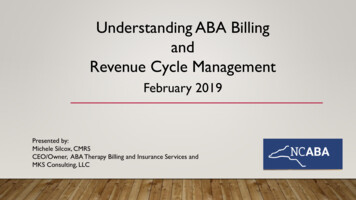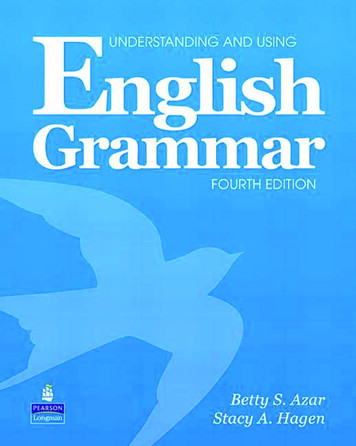
Transcription
102412 Azar FMWoAnsKey.qxd1/9/092:00 PMPage iEnglishGrammarUNDERSTANDING AND USINGFOURTH EDITIONBetty S. AzarStacy A. HagenDESIGN SERVICES OF
102412 Azar FMWoAnsKey.qxd1/9/092:00 PMPage vContentsPreface to the Fourth Edition . . . . . . . . . . . . . . . . . . . . . . . . . . . . . . . . . . . . . . . . . . . . . . . . . xiAcknowledgments . . . . . . . . . . . . . . . . . . . . . . . . . . . . . . . . . . . . . . . . . . . . . . . . . . . . . . . . xiiiChapter 1OVERVIEW OF VERB TENSES . . . . . . . . . . . . . . . . . . . . . . . . . . . . . . . . . . . . . . . . 11-1 The simple tenses . . . . . . . . . . . . . . . . . . . . . . . . . . . . . . . . . . . . . . . . . . . . . 21-2 The progressive tenses . . . . . . . . . . . . . . . . . . . . . . . . . . . . . . . . . . . . . . . . . 31-3 The perfect tenses . . . . . . . . . . . . . . . . . . . . . . . . . . . . . . . . . . . . . . . . . . . . 41-4 The perfect progressive tenses . . . . . . . . . . . . . . . . . . . . . . . . . . . . . . . . . . . 51-5 Summary chart of verb tenses . . . . . . . . . . . . . . . . . . . . . . . . . . . . . . . . . . . . 61-6 Spelling of -ing and -ed forms . . . . . . . . . . . . . . . . . . . . . . . . . . . . . . . . . . 10Chapter 2PRESENT AND PAST; SIMPLE AND PROGRESSIVE . . . . . . . . . . . . . . . . . . . . . . . 132-1 Simple present . . . . . . . . . . . . . . . . . . . . . . . . . . . . . . . . . . . . . . . . . . . . . . 142-2 Present progressive . . . . . . . . . . . . . . . . . . . . . . . . . . . . . . . . . . . . . . . . . . . 142-3 Non-progressive verbs . . . . . . . . . . . . . . . . . . . . . . . . . . . . . . . . . . . . . . . . 162-4 Regular and irregular verbs . . . . . . . . . . . . . . . . . . . . . . . . . . . . . . . . . . . . . 202-5 Irregular verb list . . . . . . . . . . . . . . . . . . . . . . . . . . . . . . . . . . . . . . . . . . . . 202-6 Regular verbs: pronunciation of -ed endings . . . . . . . . . . . . . . . . . . . . . . . . 272-7 Simple past . . . . . . . . . . . . . . . . . . . . . . . . . . . . . . . . . . . . . . . . . . . . . . . . . 292-8 Past progressive . . . . . . . . . . . . . . . . . . . . . . . . . . . . . . . . . . . . . . . . . . . . . 292-9 Using progressive verbs with always . . . . . . . . . . . . . . . . . . . . . . . . . . . . . 332-10 Using expressions of place with progressive verbs . . . . . . . . . . . . . . . . . . . . 34Chapter 3PERFECT AND PERFECT PROGRESSIVE TENSES . . . . . . . . . . . . . . . . . . . . . . . . 363-1 Present perfect . . . . . . . . . . . . . . . . . . . . . . . . . . . . . . . . . . . . . . . . . . . . . . 383-2 Have and has in spoken English . . . . . . . . . . . . . . . . . . . . . . . . . . . . . . . . 423-3 Present perfect vs. simple past . . . . . . . . . . . . . . . . . . . . . . . . . . . . . . . . . . . 433-4 Present perfect progressive . . . . . . . . . . . . . . . . . . . . . . . . . . . . . . . . . . . . . 463-5 Past perfect . . . . . . . . . . . . . . . . . . . . . . . . . . . . . . . . . . . . . . . . . . . . . . . . 503-6 Had in spoken English . . . . . . . . . . . . . . . . . . . . . . . . . . . . . . . . . . . . . . . . 533-7 Past perfect progressive . . . . . . . . . . . . . . . . . . . . . . . . . . . . . . . . . . . . . . . . 55Chapter 4FUTURE TIME . . . . . . . . . . . . . . . . . . . . . . . . . . . . . . . . . . . . . . . . . . . . . . . . . . . 604-1 Simple future: will and be going to . . . . . . . . . . . . . . . . . . . . . . . . . . . . . . 614-2 Will vs. be going to . . . . . . . . . . . . . . . . . . . . . . . . . . . . . . . . . . . . . . . . . . 634-3 Expressing the future in time clauses . . . . . . . . . . . . . . . . . . . . . . . . . . . . . 674-4 Using the present progressive and the simple present toexpress future time . . . . . . . . . . . . . . . . . . . . . . . . . . . . . . . . . . . . . . . . . . . 69CONTENTS vDESIGN SERVICES OF
102412 Azar FMWoAnsKey.qxd4-54-61/9/092:00 PMPage viFuture progressive . . . . . . . . . . . . . . . . . . . . . . . . . . . . . . . . . . . . . . . . . . . 71Future perfect and future perfect progressive . . . . . . . . . . . . . . . . . . . . . . . 73Chapter 5REVIEW OF VERB TENSES . . . . . . . . . . . . . . . . . . . . . . . . . . . . . . . . . . . . . . . . . 76Chapter 6SUBJECT-VERB AGREEMENT . . . . . . . . . . . . . . . . . . . . . . . . . . . . . . . . . . . . . . . 846-1 Final -s/-es: use, pronunciation, and spelling . . . . . . . . . . . . . . . . . . . . . . . 856-2 Basic subject-verb agreement . . . . . . . . . . . . . . . . . . . . . . . . . . . . . . . . . . . 876-3 Subject-verb agreement: using expressions of quantity . . . . . . . . . . . . . . . . 896-4 Subject-verb agreement: using there be . . . . . . . . . . . . . . . . . . . . . . . . . 916-5 Subject-verb agreement: some irregularities . . . . . . . . . . . . . . . . . . . . . . . . 93Chapter 7NOUNS . . . . . . . . . . . . . . . . . . . . . . . . . . . . . . . . . . . . . . . . . . . . . . . . . . . . . . 1007-1 Regular and irregular plural nouns . . . . . . . . . . . . . . . . . . . . . . . . . . . . . . 1017-2 Possessive nouns . . . . . . . . . . . . . . . . . . . . . . . . . . . . . . . . . . . . . . . . . . . . 1057-3 Nouns as adjectives . . . . . . . . . . . . . . . . . . . . . . . . . . . . . . . . . . . . . . . . . 1077-4 Count and noncount nouns . . . . . . . . . . . . . . . . . . . . . . . . . . . . . . . . . . . 1097-5 Noncount nouns . . . . . . . . . . . . . . . . . . . . . . . . . . . . . . . . . . . . . . . . . . . 1107-6 Some common noncount nouns . . . . . . . . . . . . . . . . . . . . . . . . . . . . . . . . 1107-7 Basic article usage . . . . . . . . . . . . . . . . . . . . . . . . . . . . . . . . . . . . . . . . . . 1147-8 General guidelines for article usage . . . . . . . . . . . . . . . . . . . . . . . . . . . . . . 1187-9 Expressions of quantity used with count and noncount nouns . . . . . . . . . . 1227-10 Using a few and few; a little and little . . . . . . . . . . . . . . . . . . . . . . . . . . 1267-11 Singular expressions of quantity: one, each, every . . . . . . . . . . . . . . . . . . 1297-12 Using of in expressions of quantity . . . . . . . . . . . . . . . . . . . . . . . . . . . . . . 131Chapter 8PRONOUNS . . . . . . . . . . . . . . . . . . . . . . . . . . . . . . . . . . . . . . . . . . . . . . . . . . 1358-1 Personal pronouns . . . . . . . . . . . . . . . . . . . . . . . . . . . . . . . . . . . . . . . . . . 1368-2 Personal pronouns: agreement with generic nouns andindefinite pronouns . . . . . . . . . . . . . . . . . . . . . . . . . . . . . . . . . . . . . . . . . 1408-3 Personal pronouns: agreement with collective nouns . . . . . . . . . . . . . . . . . 1428-4 Reflexive pronouns . . . . . . . . . . . . . . . . . . . . . . . . . . . . . . . . . . . . . . . . . . 1438-5 Using you, one, and they as impersonal pronouns . . . . . . . . . . . . . . . . . . 1478-6 Forms of other . . . . . . . . . . . . . . . . . . . . . . . . . . . . . . . . . . . . . . . . . . . . . 1488-7 Common expressions with other . . . . . . . . . . . . . . . . . . . . . . . . . . . . . . . 152Chapter 9MODALS, PART 1 . . . . . . . . . . . . . . . . . . . . . . . . . . . . . . . . . . . . . . . . . . . . . . . 1579-1 Basic modal introduction . . . . . . . . . . . . . . . . . . . . . . . . . . . . . . . . . . . . . 1579-2 Polite requests with “I” as the subject . . . . . . . . . . . . . . . . . . . . . . . . . . . . 1589-3 Polite requests with “you” as the subject . . . . . . . . . . . . . . . . . . . . . . . . . 1599-4 Polite requests with would you mind . . . . . . . . . . . . . . . . . . . . . . . . . . . 1609-5 Expressing necessity: must, have to, have got to . . . . . . . . . . . . . . . . . . 1649-6 Lack of necessity and prohibition: have to and must in the negative . . . . 1659-7 Advisability: should, ought to, had better . . . . . . . . . . . . . . . . . . . . . . . 1679-8 The past form of should . . . . . . . . . . . . . . . . . . . . . . . . . . . . . . . . . . . . . 1709-9 Obligation: be supposed to . . . . . . . . . . . . . . . . . . . . . . . . . . . . . . . . . . . 1739-10 Unfulfilled intentions: was /were going to . . . . . . . . . . . . . . . . . . . . . . . . 1769-11 Making suggestions: let’s, why don’t, shall I /we . . . . . . . . . . . . . . . . . . 1779-12 Making suggestions: could vs. should . . . . . . . . . . . . . . . . . . . . . . . . . . . 178vi CONTENTSDESIGN SERVICES OF
102412 Azar FMWoAnsKey.qxd1/9/092:00 PMPage viiChapter 10 MODALS, PART 2 . . . . . . . . . . . . . . . . . . . . . . . . . . . . . . . . . . . . . . . . . . . . . . . 18010-1 Degrees of certainty: present time . . . . . . . . . . . . . . . . . . . . . . . . . . . . . . . 18010-2 Degrees of certainty: present time negative . . . . . . . . . . . . . . . . . . . . . . . . 18310-3 Degrees of certainty: past time . . . . . . . . . . . . . . . . . . . . . . . . . . . . . . . . . 18610-4 Degrees of certainty: future time . . . . . . . . . . . . . . . . . . . . . . . . . . . . . . . . 18910-5 Progressive forms of modals . . . . . . . . . . . . . . . . . . . . . . . . . . . . . . . . . . . 19310-6 Ability: can and could . . . . . . . . . . . . . . . . . . . . . . . . . . . . . . . . . . . . . . . 19810-7 Using would to express a repeated action in the past . . . . . . . . . . . . . . . . 20010-8 Expressing preference: would rather . . . . . . . . . . . . . . . . . . . . . . . . . . . . 20110-9 Combining modals with phrasal modals . . . . . . . . . . . . . . . . . . . . . . . . . . 20210-10 Summary chart of modals and similar expressions . . . . . . . . . . . . . . . . . . 204Chapter 11 THE PASSIVE . . . . . . . . . . . . . . . . . . . . . . . . . . . . . . . . . . . . . . . . . . . . . . . . . . 21111-1 Active vs. passive . . . . . . . . . . . . . . . . . . . . . . . . . . . . . . . . . . . . . . . . . . . 21111-2 Tense forms of the passive . . . . . . . . . . . . . . . . . . . . . . . . . . . . . . . . . . . . 21311-3 Using the passive . . . . . . . . . . . . . . . . . . . . . . . . . . . . . . . . . . . . . . . . . . . 21411-4 The passive form of modals and phrasal modals . . . . . . . . . . . . . . . . . . . . 22011-5 Non-progressive passive . . . . . . . . . . . . . . . . . . . . . . . . . . . . . . . . . . . . . . 22711-6 Common non-progressive passive verbs prepositions . . . . . . . . . . . . . . . 22911-7 The passive with get . . . . . . . . . . . . . . . . . . . . . . . . . . . . . . . . . . . . . . . . . 23311-8 Participial adjectives . . . . . . . . . . . . . . . . . . . . . . . . . . . . . . . . . . . . . . . . . 236Chapter 12 NOUN CLAUSES . . . . . . . . . . . . . . . . . . . . . . . . . . . . . . . . . . . . . . . . . . . . . . . 24212-1 Introduction . . . . . . . . . . . . . . . . . . . . . . . . . . . . . . . . . . . . . . . . . . . . . . . 24212-2 Noun clauses beginning with a question word . . . . . . . . . . . . . . . . . . . . . . 24412-3 Noun clauses beginning with whether or if . . . . . . . . . . . . . . . . . . . . . . . 24912-4 Question words followed by infinitives . . . . . . . . . . . . . . . . . . . . . . . . . . . 25212-5 Noun clauses beginning with that . . . . . . . . . . . . . . . . . . . . . . . . . . . . . . 25312-6 Quoted speech . . . . . . . . . . . . . . . . . . . . . . . . . . . . . . . . . . . . . . . . . . . . . 25812-7 Reported speech: verb forms in noun clauses . . . . . . . . . . . . . . . . . . . . . . 26112-8 Using -ever words . . . . . . . . . . . . . . . . . . . . . . . . . . . . . . . . . . . . . . . . . . 268Chapter 13 ADJECTIVE CLAUSES . . . . . . . . . . . . . . . . . . . . . . . . . . . . . . . . . . . . . . . . . . . 27013-1 Adjective clause pronouns used as the subject . . . . . . . . . . . . . . . . . . . . . . 27013-2 Adjective clause pronouns used as the object of a verb . . . . . . . . . . . . . . . 27313-3 Adjective clause pronouns used as the object of a preposition . . . . . . . . . . 27413-4 Using whose . . . . . . . . . . . . . . . . . . . . . . . . . . . . . . . . . . . . . . . . . . . . . . 27713-5 Using where in adjective clauses . . . . . . . . . . . . . . . . . . . . . . . . . . . . . . . 27913-6 Using when in adjective clauses . . . . . . . . . . . . . . . . . . . . . . . . . . . . . . . . 28013-7 Using adjective clauses to modify pronouns . . . . . . . . . . . . . . . . . . . . . . . 28313-8 Punctuating adjective clauses . . . . . . . . . . . . . . . . . . . . . . . . . . . . . . . . . . 28513-9 Using expressions of quantity in adjective clauses . . . . . . . . . . . . . . . . . . . 29013-10 Using which to modify a whole sentence . . . . . . . . . . . . . . . . . . . . . . . . . 29113-11 Reducing adjective clauses to adjective phrases . . . . . . . . . . . . . . . . . . . . . 294Chapter 14 GERUNDS AND INFINITIVES, PART 1 . . . . . . . . . . . . . . . . . . . . . . . . . . . . . . . . 30114-1 Gerunds: introduction . . . . . . . . . . . . . . . . . . . . . . . . . . . . . . . . . . . . . . . 30114-2 Using gerunds as the objects of prepositions . . . . . . . . . . . . . . . . . . . . . . . 30214-3 Common verbs followed by gerunds . . . . . . . . . . . . . . . . . . . . . . . . . . . . . 307CONTENTS viiDESIGN SERVICES OF
102412 Azar :00 PMPage viiiGo gerund . . . . . . . . . . . . . . . . . . . . . . . . . . . . . . . . . . . . . . . . . . . . . . 309Special expressions followed by -ing . . . . . . . . . . . . . . . . . . . . . . . . . . . . . 310Common verbs followed by infinitives . . . . . . . . . . . . . . . . . . . . . . . . . . . . 313Common verbs followed by either infinitives or gerunds . . . . . . . . . . . . . . 317It infinitive; gerunds and infinitives as subjects . . . . . . . . . . . . . . . . . . . 322Reference list of verbs followed by gerunds . . . . . . . . . . . . . . . . . . . . . . . . 324Reference list of verbs followed by infinitives . . . . . . . . . . . . . . . . . . . . . . . 325Chapt
DESIGN SERVICES OF English Grammar UNDERSTANDING AND USING FOURTH EDITION Betty S. Azar Stacy A. Hagen 102412_Azar_FMWoAnsKey.qxd 1/9/09 2:00 PM Page iFile Size: 643KBPage Count: 25


